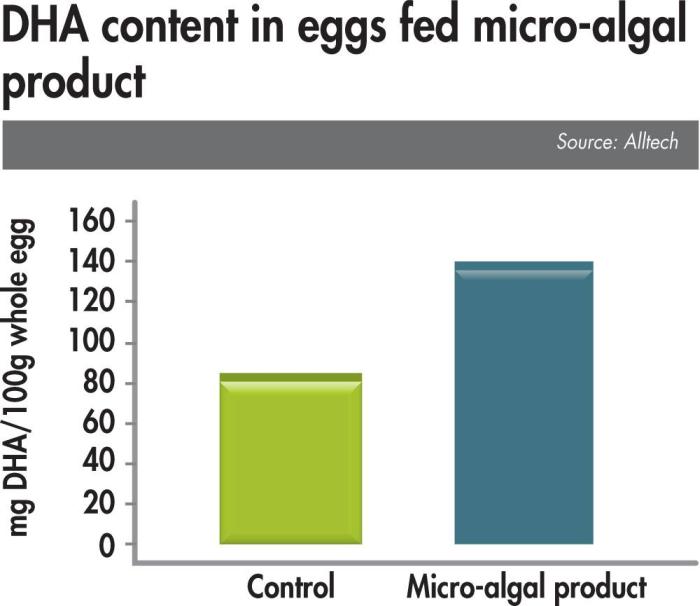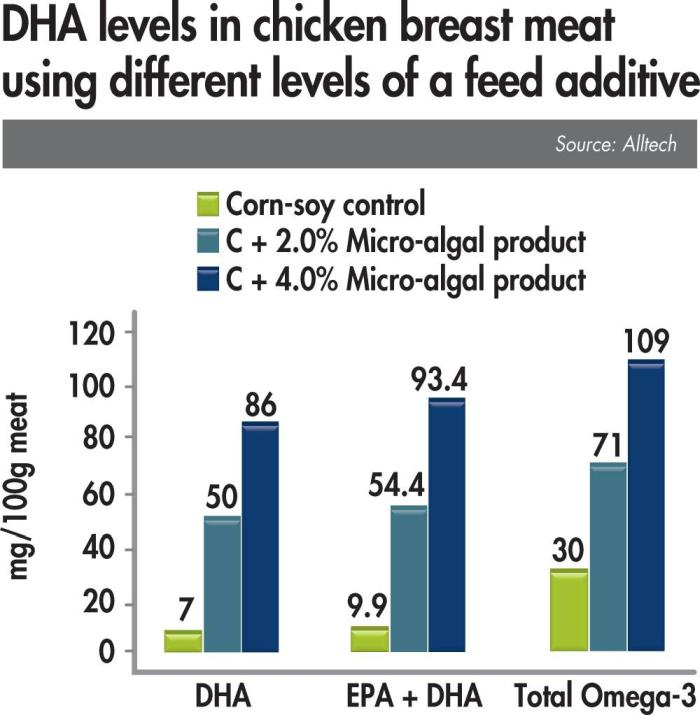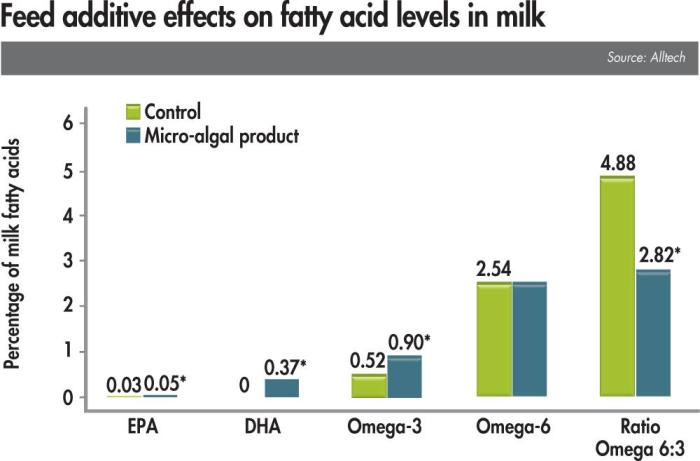WattAgNett: How animal feed additives create meat, egg superfoods22-02-2016
Selenium and DHA are two nutrients that many people are not getting enough of in their diets. It is possible to feed livestock higher than usual levels to produce enriched milk, meat and eggs that can then be marketed as improving human health and nutrition. | Milovan Radmanovac, Dreamstime.com
Written February 22, 2016
By Zoe Kay
Supplementing livestock feed produces enriched animal products that have the potential to improve the health and nutrition of those that eat them.There is a trend in human nutrition to identify new super foods. They are sold as providing health-giving nutrients in a natural package — for example, pomegranate juice as a powerful antioxidant or oats for their cholesterol-reducing ability. What if the health benefits of animal products could be similarly marketed to take advantage of the well-being market? It is possible to feed animals higher levels of certain nutrients to enrich the eggs, meat or milk they produce. The examples used in this article will be selenium and omega-3/DHA enriched eggs, meat and dairy products. These nutrients are well known to the general public as having health-promoting abilities, and in most populations, intakes are too low. Instead of taking these nutrients as a supplement, their availability is improved by supplying them as part of a food. Around the world, several enriched brands are successfully selling — perhaps producers could take further advantage of the opportunities for enrichment. Benefits to human nutritionSelenium is a powerful antioxidant, part of the enzyme glutathione peroxidase, which protects cells from damage by free radicals. It is also known to be important for immunity and fertility. There is concern that most people are not getting enough selenium. For example, the UK reference nutrient intakes (RNI) for selenium are 60 microgram (mcg) for women (.06 mg) and 75 mcg (.075 mg) for men; however, estimates suggest the average intake is only 39 mcg per day (.039 mg). It can be difficult to increase your selenium intake, particularly if you live in an area where the soils are depleted. Omega-3s are essential fatty acids, and DHA is the one that is particularly important for cognitive function and heart health. Research has shown that increasing dietary levels of omega-3/DHA can lower cholesterol, regulate blood pressure and reduce the risk of heart disease. DHA is particularly important for pregnant women as it plays an important role in fetal development of the brain, eyes and nervous system. Many national health authorities recommend an intake of about 500 mg per day for adults. But actual intakes are often much lower, averaging less than half of the recommended amount. This can be attributed to low consumption of oily fish and seafood, which are the main sources of DHA. Enriched eggs up salesEggs are a good example of a successfully marketed enriched animal product. Eggs are increasingly seen as a nutrient rich, healthy food, so improving their credentials makes sense. The level in selenium-enriched brands sold means that one egg supplies 50 percent of the recommended dietary allowance (RDA) — making up the shortfall in normal dietary ranges. There have been numerous trials showing the effectiveness of increasing selenium levels in eggs by feeding hens organic selenium. (See table, “Selenium content in animal proteins per kilogram of selenium fed.”)
Omega-3 enriched eggs have been around for a while, but the ingredients fed to the hens are changing. In the past flaxseed/linseed was used to increase omega-3 levels, but now micro-algal products can directly increase DHA without “off-odors” being a concern. The figure titled “DHA content in eggs fed micro-algal product” summarizes four trials where such a product was added at 0.5 percent, increasing DHA in whole egg by 41 percent or 60 mg per 100 grams. The result is that eating two enriched eggs a day provides 50 percent of the recommended intake of DHA.
Enriching chicken and porkAs with eggs, organic selenium has been used to effectively enrich both chicken and pork. (See table, “Selenium content in animal proteins per kilogram of selenium fed.”) By increasing the amount added to feed, over and above what is required for maintenance, levels in the meat can be doubled. The validity of enriched pork as a way of increasing levels in humans has been evaluated. Subjects who consumed enriched pork three times a week for one month increased their blood serum selenium levels by 14 to 17 percent and oxidative status. More recently the possibility of enriching chicken meat with omega-3/DHA has been investigated. The fatty acid profile breast meat can be improved by the addition of a micro-algae product high in omega-3. (See “DHA levels in chicken breast meat using different feed additives.”) In this trial, DHA levels were increased seven- to 12-fold, significantly affecting the daily intake of someone eating enriched chicken.
Similar trials have been carried out to alter the fatty acid profile of pork. A recent study added 0.5 percent of a micro-algal product to grower and finisher diets for pigs. A 4.5 to 5 times increase in the DHA content of pork loin was seen, with an even greater increase of 6.5 times observed in the back fat. Dairy productsDue to high consumption of dairy products in most countries and the nutrient density of milk, they make an excellent candidate for enrichment. Omega-3 enriched dairy products have been on the market for some time. As well as ideal intakes of omega-3s, the ratio of omega-6 to omega-3 in the diet as a whole is key to health. In most cases too much omega-6 is consumed, mainly from the cereals and vegetable oils eaten. The ratio of omega-6:omega-3 in Western diets is currently estimated at 15-20:1, instead of an optimal 1-4:1. A trial in lactating dairy cows showed that by supplementing the diets with a product rich in omega-3s this ratio could be reduced. (See figure, “Feed additive effects on fatty acid levels in milk.”) A series of studies in Europe with the same product observed that, in general, there were increased levels of DHA, polyunsaturated fatty acids (PUFA) and decreased levels of saturated fat in the milk.
Importantly, in terms of cost-effectiveness, there was a significant increase in milk yield, without any increase in dry matter intake. And improvements in fertility and herd health were suggested. Animal benefits in additive feedingAdding organic selenium to livestock diets doesn’t just benefit the people that consume them. Parameters including fertility, immunity and growth are improved. The quality of the products themselves is also affected; for example, less drip loss in chicken and pork is reduced and shell strength of eggs increased. Similarly, increasing dietary levels of DHA optimizes flock or herd health and productivity. Trials have shown improvements in the immunity, fertility and growth in chickens, pigs and cattle. These benefits may go part or all the way to paying for the cost of feeding extra nutrients, thereby increasing the potential profit margin for these premium animal products. Marketing opportunitiesEnrichment is not limited to one nutrient; on-going research is looking at the opportunities of enriching animal products with combinations. In this way, two eggs, a piece of chicken or a few glasses of milk could make up the deficit in several RDAs. Combining the health benefits of selenium and omega-3s together, for example, increases both the marketing opportunities as well as the health benefits. The connection between food and health is becoming more apparent to consumers. Producers have the ability to promote the fact that animal products can deliver health-giving nutrients. Taking advantage of the opportunity to market milk, meat and eggs as super foods offers a way to differentiate and add value throughout the supply chain.
Zoe Kay is an independent consultant providing technical services to the animal health and nutrition industry. She can be reached at cuckooconsulting@gmail.com.
|
Inloggen op de ledenportal
.png)



